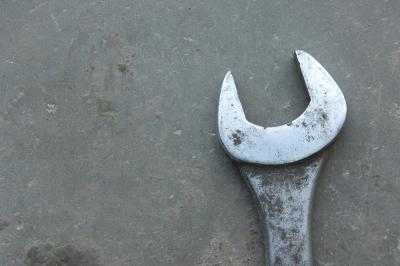
Driving down a road and feeling the front end of your car pulling you one way or another can be a nuisance and sometimes a safety problem. Your car should move in a straight direction when your steering wheel is centered. If not, you may have an alignment problem. Though many car repair shops portray front-end alignment as rocket science, often you can align your car in your own garage with some common household tools.
Check the tires' toe, the angles the tires are facing. Park the vehicle on level ground, such as a garage or street. With the steering wheel centered and tires facing straight ahead, jack up one of the front tires with a tire jack. Use jack stands to secure the vehicle. Spray paint a stripe on the tread as you spin the tire a full revolution.
Using a small nail, inscribe a straight line into the paint, lightly pressed against the tire. Place this line throughout the whole tire as it's spinning. Position the line on the tread blocks to make it easier and continuous around the whole tire. Repeat the steps for the other front-end tire.
Measure from line to line on both tires on the front of the tire. Ensure that the tape is level across your measurement. Repeat the step on the back of the tire. Compare the two measurements. The difference is your toe, the amount of angle that the tire is misaligned.
Loosen the tie-rod adjuster sleeves. Use a penetrating lubricant to help break the nuts loose. This lubricant can be found at most auto parts stores.
With the steering wheel centered, adjust the tie-rods, the bar that controls steering in your vehicle. With the adjuster sleeves loosened, adjust the rods equally. Remove the jack stands and jack. Place the car in neutral and manually roll the car back and forth several feet, a couple of times. This transfers your alignment to the tires. Repeat this step until your measurements of the toe are in check.
Complete the alignment by torquing and tightening the adjuster sleeves.